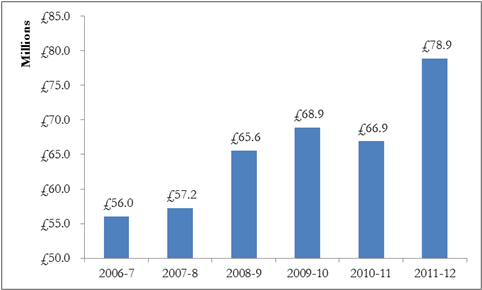HMRC tax yield from construction sector compliance investigations jumps 18% in one year
Date: 28th March 2013
HMRC's yield from tax compliance investigations in the construction sector leapt 18% to £78.9million last year from £66.9million the year before, says NoPalaver Group, a leading provider of accounting services to contractors.
HMRC's yield from tax compliance investigations into the construction sector last year was the highest in the last five years (see graph below).
NoPalaver says that HMRC's construction sector crackdown is part of a wider effort to boost tax revenue through compliance work, and that HMRC has targeted the construction sector as it is seen as an easy target.
Graham Jenner, Director at No Palaver, says: "Working arrangements in the construction sector are complex with self-employed subcontractors moving between jobs on a regular basis. Irregular working patterns like this create plenty of opportunities for errors with paperwork and tax codes."
"HMRC has dedicated teams to focus on tax compliance issues in the construction sector. It's one of the few industries that attract such specific attention from HMRC."
Graham Jenner adds: "HMRC likes to target the construction sector because a little bit of extra effort on compliance work often turns up extra tax revenue from contractors and sub-contractors."
"However, the compliance yield from the construction sector is very small compared to the yield from HMRC's overall compliance investigations. This begs the question as to why HMRC is spending time pursuing small contractors and sub-contractors when it could be focusing its limited budget on the tax affairs of much bigger businesses."
NoPalaver says HMRC's construction sector compliance investigations focus on three key areas:
- PAYE compliance;
- 'Construction Industry Scheme' compliance;
- And other 'disguised worker' issues, where contractors treat employees as sub-contractors in order to avoid taxes.
Graham Jenner explains: "HMRC will focus most of its attention on potential errors made by construction contractors and sub-contractors on compliance with the 'Construction Industry Scheme' and 'disguised worker' issues."
"These types of tax investigations underscore how important good record-keeping is for construction businesses and workers. Contractors need a well-ordered paper trail to prove to HMRC that their tax treatment of a sub-contractor is justified."
"However, HMRC knows that construction firms' record-keeping can be lax and will take advantage of any lack of paperwork to demand extra taxes."
HMRC's Construction Industry Scheme (CIS) was introduced in 2007 and regulates payments made from contractors to subcontractors in the construction industry, and the taxes that are deducted from subcontractors' pay.Graham Jenner comments: "The way HMRC has set up the CIS makes it very easy for construction contractors to make compliance errors, even if they have kept good records."
NoPalaver explains that under the CIS, sub-contractors are given a code by HMRC. This code determines how much tax is deducted from their pay – the amount changes from sub-contractor to sub-contractor.
Under CIS, some sub-contractors will have 30% tax deducted from their pay, while some sub-contractors could have no tax deducted if HMRC expects them to file a self-assessment tax return at the end of the year.
Graham Jenner says: "Under the old scheme, subcontractors were given a photo ID to support their HMRC code – but under the new scheme they are just given a code."
"This makes it very easy for a sub-contractor who should have 30% of their pay deducted to present a contractor with a code that belongs to a sub-contractor who does not have any tax deducted."
"It can be difficult for contractors to prevent this from happening, but it could be the contractor that is on the hook for the missing taxes when HMRC discovers there is a problem."
Yields from HMRC compliance investigations into construction sector



